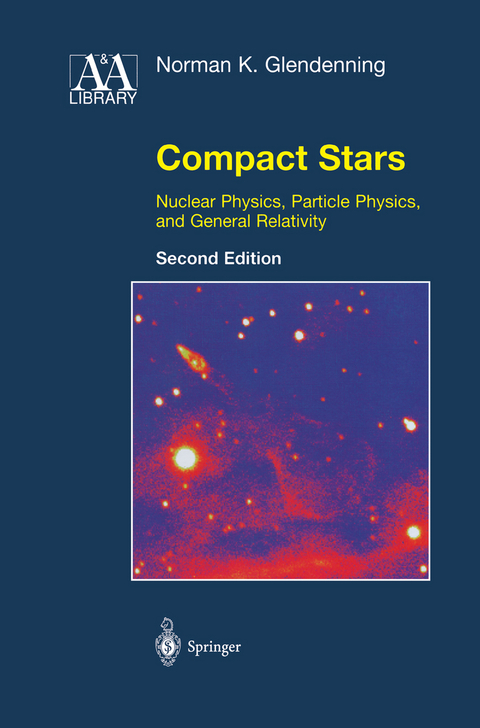
Compact Stars
Springer-Verlag New York Inc.
978-1-4612-7045-4 (ISBN)
1 Introduction.- 1.1 Compact Stars.- 1.2 Compact Stars and Relativistic Physics.- 1.3 Compact Stars and Dense-Matter Physics.- 2 General Relativity.- 2.1 Relativity.- 2.2 Lorentz Invariance.- 2.3 Scalars, Vectors, and Tensors in Curvilinear Coordinates.- 2.4 Principle of Equivalence of Inertia and Gravitation.- 2.5 Gravity.- 2.6 Covariance.- 2.7 Riemann Curvature Tensor.- 2.8 Einstein’ Field Equations.- 2.9 Relativistic Stars.- 2.10 Action Principle in Gravity.- 2.11 Problems for Chapter 2.- 3 Compact Stars: From Dwarfs to Black Holes.- 3.1 Birth and Death of Stars.- 3.2 Objective.- 3.3 Gravitational Units and Neutron Star Size.- 3.4 Partial Decoupling of Matter from Gravity.- 3.5 Equations of Relativistic Stellar Structure.- 3.6 Electrical Neutrality of Stars.- 3.7 “Constancy” of the Chemical Potential.- 3.8 Gravitational Redshift.- 3.9 White Dwarfs and Neutron Stars.- 3.10 Improvements in White Dwarf Models.- 3.11 Temperature and Neutron Star Surface.- 3.12 Stellar Sequences from White Dwarfs to Neutron Stars.- 3.13 Baryon Number of a Star.- 3.14 Binding Energy of a Neutron Star.- 3.15 Star of Uniform Density.- 3.16 Scaling Solution of the OV Equations.- 3.17 Bound on Maximum Mass of Neutron Stars.- 3.18 Stability.- 3.19 Beyond the Maximum-Mass Neutron Star.- 3.20 Black Holes.- 3.21 Problems for Chapter 3.- 4 Relativistic Nuclear Field Theory.- 4.1 Motivation.- 4.2 Lagrange Formalism.- 4.3 Symmetries and Conservation Laws.- 4.4 Boson and Fermion Fields.- 4.5 Properties of Nuclear Matter.- 4.6 The ? — ? Model.- 4.7 Stationarity of Energy Density.- 4.8 Model with Scalar Self-Interactions.- 4.9 Introduction of Isospin Force.- 4.10 Inclusion of the Octet of Baryons.- 4.11 High-Density Limit.- 4.12 Effective Versus Renormalized Theory.- 4.13 Bound Versus UnboundNeutron Matter.- 4.14 Note on Dimensions.- 4.15 Summary.- 4.16 Problems for Chapter 4.- 5 Neutron Stars.- 5.1 Discovery.- 5.2 Pulsars: The Observational Basis of Neutron Stars.- 5.3 Theory of Neutron Stars.- 5.4 Constitution of Neutron Stars.- 5.5 Tables of Equations of State.- 5.6 Problems for Chapter 5.- 6 Rotating Neutron Stars.- 6.1 Motivation.- 6.2 Dragging of Local Inertial Frames.- 6.3 Interior Solution for the Dragging Frequency.- 6.4 Moment of Inertia of a Rotating Relativistic Star.- 6.5 Kepler Angular Velocity in General Relativity.- 6.6 Effect of Frame Dragging on Kepler Frequency.- 6.7 Approximation to the Kepler Frequency.- 6.8 Hartle—Thorne Perturbative Solution.- 6.9 Imprint of Angular Momentum.- 6.10 Rotating Stars with Realistic Equations of State.- 6.11 Effect of Rotation on Stellar Structure.- 6.12 Gravitational-Wave Instabilities.- 6.13 Problems for Chapter 6.- 7 Limiting Rotational Period and Radius of Neutron Stars.- 7.1 Motivation.- 7.2 The Minimal Constraints.- 7.3 Variational Ansatz.- 7.4 Limiting Value of Rotational Period as a Function of Mass.- 7.5 Test of Sensitivity of Results.- 7.6 General Relativistic Limit on Rotation.- 7.7 Lower Limit on Neutron Star Radius.- 7.8 Discussion and Alternatives.- 7.9 Self-Bound Stars.- 7.10 Summary.- 8 Quark Stars.- 8.1 Introduction.- 8.2 Model of Quark Confinement.- 8.3 Quark Matter Equation of State.- 8.4 Quark Star Matter.- 8.5 Strange and Charm Stars.- 8.6 Problems for Chapter 8.- 9 Hybrid Stars.- 9.1 Introduction.- 9.2 Constant-Pressure Phase Transition.- 9.3 The Confined—Deconfined Phase Transition in Neutron Stars.- 9.4 Large-Scale Structure of a Hybrid Star.- 9.5 Crystalline Structure of the Mixed Phase.- 9.6 Tables of Equation of State for Hybrid Stars.- 9.7 Problems for Chapter 9.- 10 BoseCondensates in Neutron Stars.- 10.1 Relativistic Mean—Field Model with Kaons.- 10.2 Equation of State with a Kaon Condensate.- 10.3 Stellar Properties.- 10.4 Summary.- 10.5 Problems for Chapter 10.- 11 Consequences and Signals of Phase Transitions.- 11.1 Introduction.- 11.2 Mechanism for Formation of Low-Mass Black Holes.- 11.3 A Third Class of Stable Compact Stars.- 11.4 Phase Transition Signal in Pulsar Timing.- 11.5 Caveats.- 12 Strange Stars.- 12.1 The Strange Matter Hypothesis.- 12.2 Compatibility of the Hypothesis with Present Knowledge.- 12.3 Submillisecond Pulsars.- 12.4 Structure of Strange Stars.- 12.5 Simultaneous Existence of Strange and Neutron Stars.- 12.6 Strange Stars to Strange Dwarfs.- 12.7 Conclusion.- Useful Astronomical Data.- Books for Further Study.- References.
| Reihe/Serie | Astronomy and Astrophysics Library |
|---|---|
| Zusatzinfo | XVIII, 468 p. |
| Verlagsort | New York, NY |
| Sprache | englisch |
| Maße | 155 x 235 mm |
| Themenwelt | Naturwissenschaften ► Physik / Astronomie ► Astronomie / Astrophysik |
| Naturwissenschaften ► Physik / Astronomie ► Atom- / Kern- / Molekularphysik | |
| ISBN-10 | 1-4612-7045-6 / 1461270456 |
| ISBN-13 | 978-1-4612-7045-4 / 9781461270454 |
| Zustand | Neuware |
| Haben Sie eine Frage zum Produkt? |
aus dem Bereich


